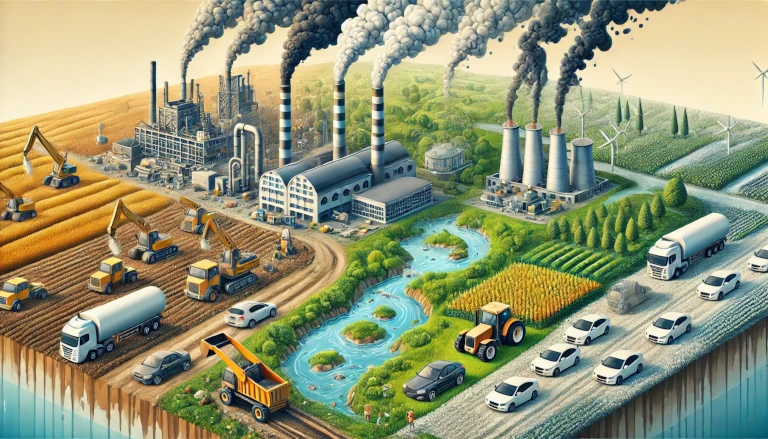Water is essential for life, but water pollution threatens this vital resource. Contaminated water not only harms aquatic life but also impacts human health, agriculture, and the environment. In this post, we will explore what water pollution is, its different sources, and how it affects ecosystems and societies. We will also provide simple examples to help explain the key concepts.
What is Water Pollution?
Water pollution occurs when harmful substances—such as chemicals, waste, or microorganisms—contaminate water bodies like rivers, lakes, oceans, and groundwater. These pollutants make the water unsafe for drinking, swimming, fishing, and other activities. Water pollution affects not only aquatic ecosystems but also human health and livelihoods.
Different Sources of Water Pollution
Water pollution can originate from several sources, broadly classified into two categories: point source pollution and non-point source pollution.
1. Industrial Waste
Factories and industrial facilities are major contributors to water pollution. They release harmful chemicals, toxins, and waste into nearby water bodies without proper treatment. This form of pollution is considered point source pollution because it comes from a specific, identifiable location.
Example: A textile manufacturing plant that discharges untreated dye and chemicals into a river is a typical case of industrial water pollution. This can lead to water becoming toxic, killing fish and making the water unusable for farming or drinking.
2. Agricultural Runoff
Non-point source pollution includes pollutants that do not come from a single location. Agricultural runoff is a prime example. When farmers use chemical fertilizers, pesticides, and herbicides, rainfall can wash these chemicals into nearby streams and rivers. This leads to water contamination and can result in eutrophication, where excessive nutrients cause algae blooms that deplete oxygen levels in the water, killing aquatic life.
Example: Fertilizers used on farmlands in the Midwest United States wash into the Mississippi River, eventually leading to the Gulf of Mexico Dead Zone, where marine life cannot survive due to low oxygen levels caused by algae blooms.
3. Sewage and Wastewater
Sewage systems and wastewater treatment plants are supposed to treat water before it is released back into the environment. However, in many developing areas, untreated or partially treated sewage is directly discharged into rivers and oceans. Human waste contains harmful bacteria, viruses, and chemicals that can make water dangerous for human use.
Example: In many parts of India, untreated sewage is dumped into rivers like the Ganges, contributing to massive water pollution and posing serious health risks for people who depend on the river for drinking water, bathing, and agriculture.
4. Marine Dumping
Oceans are often used as dumping grounds for solid waste, including plastics, metals, and even radioactive material. Over time, this waste degrades water quality and harms marine life. Plastics, in particular, break down into microplastics, which are ingested by fish and other sea creatures, eventually making their way into the human food chain.
Example: The Great Pacific Garbage Patch, a massive accumulation of plastic waste floating in the Pacific Ocean, highlights the severe impact of marine dumping on ocean health and biodiversity.
5. Oil Spills
Oil spills are another significant source of water pollution, typically resulting from accidents during oil drilling, transport, or pipeline failures. Oil spills can devastate marine ecosystems, killing fish, birds, and mammals. They also make water unusable for human purposes until cleaned.
Example: The BP Deepwater Horizon oil spill in 2010 spilled millions of barrels of oil into the Gulf of Mexico, killing marine life and damaging the livelihoods of local fishing communities.
6. Household Waste
Everyday activities in homes also contribute to water pollution. Household cleaning products, detergents, and personal care items contain chemicals that can end up in local water bodies when washed down the drain. Many people also improperly dispose of old medicines and hazardous household chemicals by flushing them down the toilet, leading to water contamination.
Example: Pharmaceuticals like painkillers, antibiotics, and hormones flushed down toilets have been found in trace amounts in water bodies, which can disrupt aquatic ecosystems and potentially impact human health.
7. Thermal Pollution
Thermal pollution occurs when industries or power plants release hot water into natural water bodies. This sudden change in temperature can be harmful to aquatic ecosystems as it decreases oxygen levels and affects the organisms that rely on stable temperatures.
Example: Nuclear power plants often discharge heated water into nearby rivers or lakes. The temperature rise can disrupt aquatic life, particularly for species sensitive to temperature changes.
8. Mining Activities
Mining activities often involve the use of chemicals like mercury and arsenic to extract minerals. These chemicals can leach into nearby water sources, contaminating them with toxic substances. Additionally, acid mine drainage occurs when rainwater reacts with the minerals in exposed rocks, producing acidic water that pollutes streams and rivers.
Example: In some areas of South Africa, mining for gold and other minerals has led to heavy metal contamination in water sources, making it unsafe for local communities and wildlife.
9. Atmospheric Deposition
Pollution in the atmosphere, such as nitrogen oxides and sulfur dioxide from vehicle emissions or industrial processes, can be carried by rain into rivers and lakes, a process known as acid rain. This type of water pollution changes the acidity of water bodies, which can harm aquatic life and affect water quality.
Example: The northeastern United States experienced significant acid rain in the 1980s, which led to the acidification of lakes and streams, harming fish populations.
10. Plastic Pollution
Plastic waste, particularly single-use plastic, is one of the most common pollutants found in water bodies today. Over time, plastic breaks down into microplastics, which are ingested by marine animals and can make their way into human food chains, posing long-term health risks.
Example: Fish and sea turtles often mistake plastic bags for jellyfish, leading to ingestion and sometimes death. In some areas, microplastics have even been found in drinking water.
Conclusion
Water pollution is a growing global concern, with various sources contributing to the contamination of our precious water resources. Whether it’s industrial waste, agricultural runoff, or everyday household activities, human actions have a significant impact on water quality. By understanding the different sources of water pollution, we can work together to reduce our environmental footprint and protect this vital resource for future generations.
Discover more from Green Ecosystem - Renewable Energy, Agriculture, and Environmental Sustainability
Subscribe to get the latest posts sent to your email.


